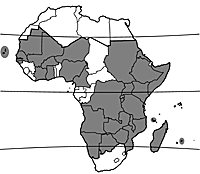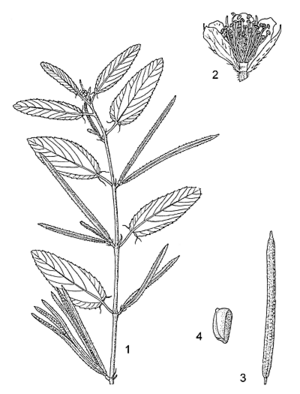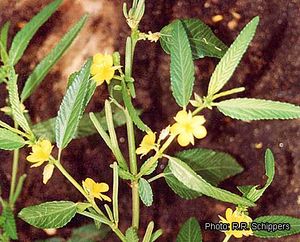Corchorus trilocularis (PROTA)
Introduction |
| General importance | |
| Geographic coverage Africa | |
| Geographic coverage World | |
| Vegetable | |
| Medicinal | |
| Forage / feed | |
| Fibre | |
| Food security | |
- Protologue: Syst. nat. ed. 12, 2: 369 (1767).
- Family: Tiliaceae (APG: Malvaceae)
- Chromosome number: 2n = 14
Vernacular names
- Jew’s mallow, wild Jew’s mallow, bush okra (En).
- Corète à trois loges (Fr).
- Coreté (Po).
- Mlendo (Sw).
Origin and geographic distribution
The genus Corchorus probably originates from Africa, with a secondary centre of diversity in the Indo-Burmese region. Corchorus trilocularis is widespread over tropical Africa and is also found in tropical and subtropical Asia and Australia. In Africa it occurs from Cape Verde and Mauritania in the west, to Somalia, Comoros, Madagascar and Mauritius in the east, and to South Africa in the south; it has been recorded for many countries.
Uses
Young tender leaves of Corchorus trilocularis are cooked into a mucilaginous product that is either used as a sauce or as relish with maize or other cereal. It is popular because cooking does not take much time and requires only small amounts of fuel. In Western Uganda people prefer the flowers to the leaves and cook them as a mucilaginous vegetable to be mixed with more coarse vegetables. Dried flowers are ground into a powder and kept for use in the dry season. The plants are grazed by animals including cattle. In Somalia the stem fibres are used for rope making.
Production and international trade
Locally Corchorus trilocularis is a popular vegetable collected from the wild for home consumption and for sale at local markets. It is only rarely cultivated on a small scale.
Properties
The composition of Corchorus trilocularis is probably comparable to that of Corchorus olitorius L.
Adulterations and substitutes
Corchorus trilocularis can be replaced by okra or other Corchorus species, especially Corchorus olitorius. In drier regions it is mainly replaced by Corchorus tridens L.
Description
- Annual herb up to 1(–1.5) m tall, usually erect, sometimes with decumbent branches; stems fibrous and tough, often somewhat woody, often pubescent on one side.
- Leaves alternate, simple; stipules setaceous, up to 1.2 cm long, pubescent; petiole up to 0.5–2.5 cm long; blade ovate or oblong to lanceolate or narrowly elliptical, (2–)4–9(–13) cm × 0.5–3(–4) cm, rounded or broadly cuneate and with or without setaceous appendages up to 1 cm long at base, acute to obtuse at apex, margin serrate or crenate, usually pubescent on the veins, 3(–5)-veined from the base.
- Inflorescence a 1–3(–4)-flowered leaf-opposed fasciculate cyme, bracteate.
- Flowers bisexual, regular, usually 5-merous, shortly stalked; sepals free, narrowly lanceolate, (3–)6–10 mm long; petals free, oblanceolate, (3–)6–10 mm long, yellow, caducous; stamens up to 40(–60); ovary superior, 3(–4)-celled, style short.
- Fruit a slender cylindrical capsule up to 7(–8) cm long and up to 3 mm wide, slightly ribbed, with short beak at apex, scabrid, covered with stellate hairs when young, dehiscing by 3(–4) valves, many-seeded.
- Seeds oblong-ovoid, 1–1.5 mm long, dark brown to black.
Other botanical information
The genus Corchorus comprises an uncertain number of species, with estimates ranging from 40–100. Corchorus trilocularis can be confused with Corchorus tridens, but the latter has distinctly spreading horns at the fruit apex. Older leaves of Corchorus tridens are less liked than those of Corchorus trilocularis because they become bitter with age, probably due to an increase in tannins. Corchorus trilocularis can also be confused with Corchorus asplenifolius Burch., especially when it is grazed or trampled and stems become decumbent, but the latter is a perennial herb with woody rootstock.
Growth and development
Once conditions of adequate moisture and a temperature of approximately 25°C are met, Corchorus trilocularis grows very fast. It has a short growing season, often no longer than 3–4 months. More luxuriant growth occurs in manured fields.
Ecology
Corchorus trilocularis occurs in a wide range of habitats, from seasonally inundated land on clay soils and river banks to grassland, roadsides and disturbed places, and from black cotton soil to semi-arid sandy soils, as long as there is a warm season. It is most common in places with residual moisture such as clay plains, where it may colonize the entire area, becoming the most abundant species. It is commonly found as a weed in irrigated fields. It appreciates high temperatures as long as there is adequate moisture in the rooting zone.
Propagation and planting
Only few people cultivate Corchorus trilocularis by broadcasting the seeds in their garden to produce a crop for home consumption.
Management
Normally Corchorus trilocularis is collected from the wild or from fields, where it is left untouched during weeding. If cultivated, the same technology may be applied as for Corchorus olitorius.
Harvesting
Shoot tips are plucked from wild plants from the moment that they are about 10 cm tall. These fresh shoots are most appreciated. Plucking of shoots continues until fruits start developing and from then on only new side shoots or individual young leaves are harvested.
Handling after harvest
The produce is mainly sold fresh and offered at the market in heaps, often with flowers and young fruits present. The leaves are stripped from shoots that are no longer tender. Such leaves are often preserved in water to keep them fresh. Alternatively, leaves may be dried and kept for use during the dry season. Dried produce will only retain about 15–20% of its original weight. When drying conditions are less than ideal, its colour changes from green to blackish and its value becomes much reduced. Sun-drying should be done on clean sheets and the produce turned over regularly to obtain a uniform and green product. Dried leaves will retain their quality for up to one year as long as they are kept dry.
Genetic resources
Corchorus trilocularis is widespread and occurs in anthropogenic habitats, and thus does not seem liable to genetic erosion. There are no germplasm collections.
Prospects
Corchorus trilocularis is locally common and offered at the market at low prices. Corchorus olitorius is preferred for cultivation because of its much higher yield capacity, thus there is little incentive to produce Corchorus trilocularis commercially.
Major references
- Edmonds, J.M., 1990. Herbarium survey of African Corchorus L. species. Systematic and Ecogeographic Studies on Crop Genepools 4. IBPGR/IJO, Rome, Italy. 284 pp.
- Leung, W.-T.W., Busson, F. & Jardin, C., 1968. Food composition table for use in Africa. FAO, Rome, Italy. 306 pp.
- Wild, H., 1963. Tiliaceae. In: Exell, A.W., Fernandes, A. & Wild, H. (Editors). Flora Zambesiaca. Volume 2, part 1. Crown Agents for Oversea Governments and Administrations, London, United Kingdom. pp. 33–91.
- Wild, H., 1984. Tiliaceae. In: Leistner, O.A. (Editor). Flora of southern Africa. Volume 21, part 1. Botanical Research Institute, Department of Agriculture, Pretoria, South Africa. 44 pp.
Other references
- Bosser, J., 1987. Tiliacées. In: Bosser, J., Cadet, T., Guého, J. & Marais, W. (Editors). Flore des Mascareignes. Familles 51–62. The Sugar Industry Research Institute, Mauritius, l’Office de la Recherche Scientifique Outre-Mer, Paris, France & Royal Botanic Gardens, Kew, Richmond, United Kingdom. 14 pp.
- Burkill, H.M., 2000. The useful plants of West Tropical Africa. 2nd Edition. Volume 5, Families S–Z, Addenda. Royal Botanic Gardens, Kew, Richmond, United Kingdom. 686 pp.
- Figueiredo, E., 1995. Tiliaceae. In: Paiva, J., Martins, E.S., Diniz, M.A., Moreira, I., Gomes, I. & Gomes, S. (Editors). Flora de Cabo Verde: Plantas vasculares. No 23. Instituto de Investigação Científica Tropical, Lisbon, Portugal & Instituto Nacional de Investigação e Desenvolvimento Agrário, Praia, Cape Verde. 17 pp.
- Schippers, R.R., 2000. African indigenous vegetables. An overview of the cultivated species. Natural Resources Institute/ACP-EU Technical Centre for Agricultural and Rural Cooperation, Chatham, United Kingdom. 214 pp.
- Vollesen, K. & Demissew Sebsebe, 1995. Tiliaceae. In: Edwards, S., Mesfin Tadesse & Hedberg, I. (Editors). Flora of Ethiopia and Eritrea. Volume 2, part 2. Canellaceae to Euphorbiaceae. The National Herbarium, Addis Ababa University, Addis Ababa, Ethiopia and Department of Systematic Botany, Uppsala University, Uppsala, Sweden. pp. 145–164.
- Wilczek, R., 1963. Tiliaceae. In: Robyns, W., Staner, P., Demaret, F., Germain, R., Gilbert, G., Hauman, L., Homès, M., Jurion, F., Lebrun, J., Vanden Abeele, M. & Boutique, R. (Editors). Flore du Congo belge et du Ruanda-Urundi. Spermatophytes. Volume 10. Institut National pour l’Étude Agronomique du Congo belge, Brussels, Belgium. pp. 1–91.
Sources of illustration
- Bosser, J., 1987. Tiliacées. In: Bosser, J., Cadet, T., Guého, J. & Marais, W. (Editors). Flore des Mascareignes. Familles 51–62. The Sugar Industry Research Institute, Mauritius, l’Office de la Recherche Scientifique Outre-Mer, Paris, France & Royal Botanic Gardens, Kew, Richmond, United Kingdom. 14 pp.
- Vollesen, K. & Demissew Sebsebe, 1995. Tiliaceae. In: Edwards, S., Mesfin Tadesse & Hedberg, I. (Editors). Flora of Ethiopia and Eritrea. Volume 2, part 2. Canellaceae to Euphorbiaceae. The National Herbarium, Addis Ababa University, Addis Ababa, Ethiopia and Department of Systematic Botany, Uppsala University, Uppsala, Sweden. pp. 145–164.
Author(s)
- R.R. Schippers, De Boeier 7, 3742 GD Baarn, Netherlands
Correct citation of this article
Schippers, R.R., 2004. Corchorus trilocularis L. [Internet] Record from PROTA4U. Grubben, G.J.H. & Denton, O.A. (Editors). PROTA (Plant Resources of Tropical Africa / Ressources végétales de l’Afrique tropicale), Wageningen, Netherlands.
Accessed 18 December 2024.



